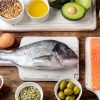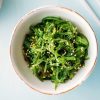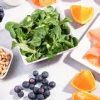- Empty cart.
- Continue Shopping
How to Understand the Nutrient Density of Foods

Nutrient density is a concept that focuses on the nutritional value of foods relative to their calorie content. Foods that are nutrient-dense provide a high concentration of essential nutrients, such as vitamins, minerals, fiber, and antioxidants, per unit of calories. Understanding nutrient density can help you make informed choices about your diet to support overall health and well-being.
1. Read Nutrition Labels
Nutrition labels on packaged foods provide valuable information about their nutrient content. Pay attention to the following aspects:
- Serving Size: Start by looking at the serving size to ensure you’re comparing similar portions when assessing nutrient density.
- Calories: Check the calorie content per serving. Nutrient-dense foods typically have fewer calories for the same serving size.
- Nutrients: Examine the percentages of essential nutrients like vitamins (e.g., vitamin A, vitamin C), minerals (e.g., calcium, iron), and dietary fiber. Higher percentages indicate greater nutrient density.
- Ingredients: Review the ingredient list. Foods with shorter ingredient lists that contain whole, unprocessed ingredients are often more nutrient-dense.
2. Use the Nutrient Density Score
Nutrient density scores are numerical values assigned to foods based on their nutrient content relative to calories. These scores can help you quickly identify nutrient-dense foods. Higher scores indicate greater nutrient density. Some nutrient density scores are used in popular dietary frameworks like the Nutrient Density Index (NDI) or the Nutrient-Rich Foods Index (NRF9.3).
3. Focus on Whole, Unprocessed Foods
Whole, unprocessed foods are generally more nutrient-dense than highly processed foods. Opt for fresh fruits and vegetables, whole grains, lean proteins, nuts, and seeds. These foods are rich in vitamins, minerals, and other essential nutrients without added sugars, unhealthy fats, or excessive calories.
4. Consider Nutrient-Rich Food Groups
Certain food groups are known for their high nutrient density:
- Leafy Greens: Foods like kale, spinach, and Swiss chard are packed with vitamins, minerals, and antioxidants while being low in calories.
- Berries: Berries like blueberries, strawberries, and raspberries are rich in vitamins, fiber, and antioxidants.
- Lean Proteins: Skinless poultry, fish, lean cuts of meat, and plant-based protein sources like tofu and legumes offer protein and essential nutrients with relatively low calorie content.
- Whole Grains: Foods like quinoa, brown rice, and oats are excellent sources of fiber, vitamins, and minerals compared to refined grains.
- Nuts and Seeds: Almonds, walnuts, chia seeds, and flaxseeds are nutrient-dense sources of healthy fats, fiber, and essential nutrients.
5. Limit Empty-Calorie Foods
Foods that are high in calories but low in essential nutrients are considered “empty-calorie” foods. These include sugary beverages, candy, chips, and certain fast foods. While these foods may provide energy, they offer little to no nutritional value and can lead to overconsumption of calories without meeting nutrient needs.
6. Balance Macronutrients
A balanced diet that includes a variety of macronutrients (carbohydrates, proteins, fats) can contribute to overall nutrient density. For example, choosing complex carbohydrates like whole grains, lean proteins, and healthy fats ensures that you’re getting a wide range of essential nutrients.
In Conclusion, Understanding the nutrient density of foods is essential for making informed dietary choices that support your health and well-being. By reading nutrition labels, using nutrient density scores, focusing on whole, unprocessed foods, and emphasizing nutrient-rich food groups, you can optimize your diet to provide essential nutrients while managing calorie intake. A balanced diet that prioritizes nutrient-dense foods is a key component of maintaining good health and preventing nutrient deficiencies.








